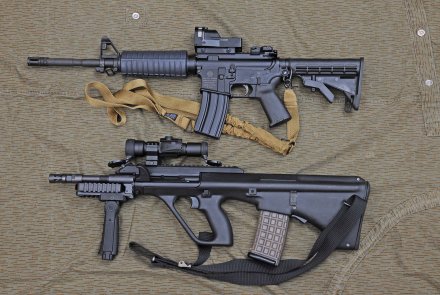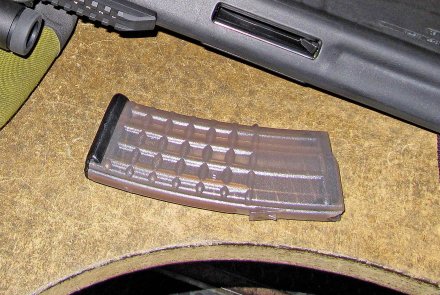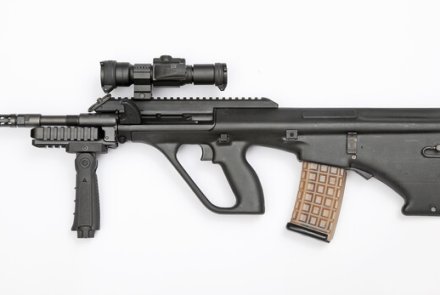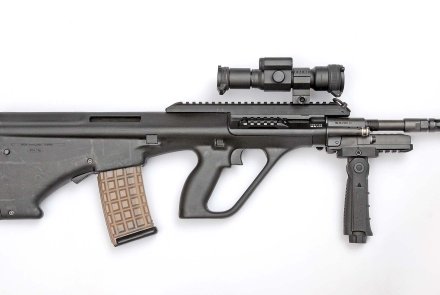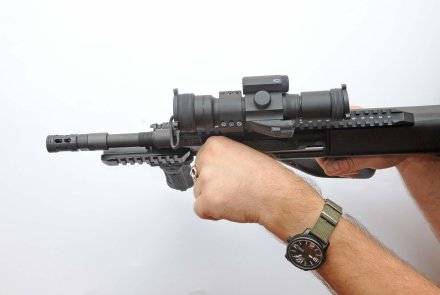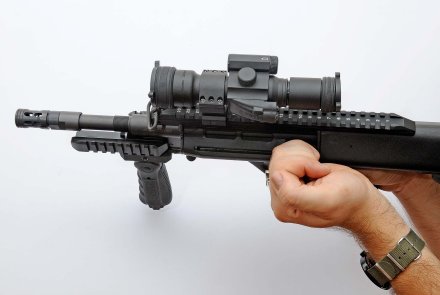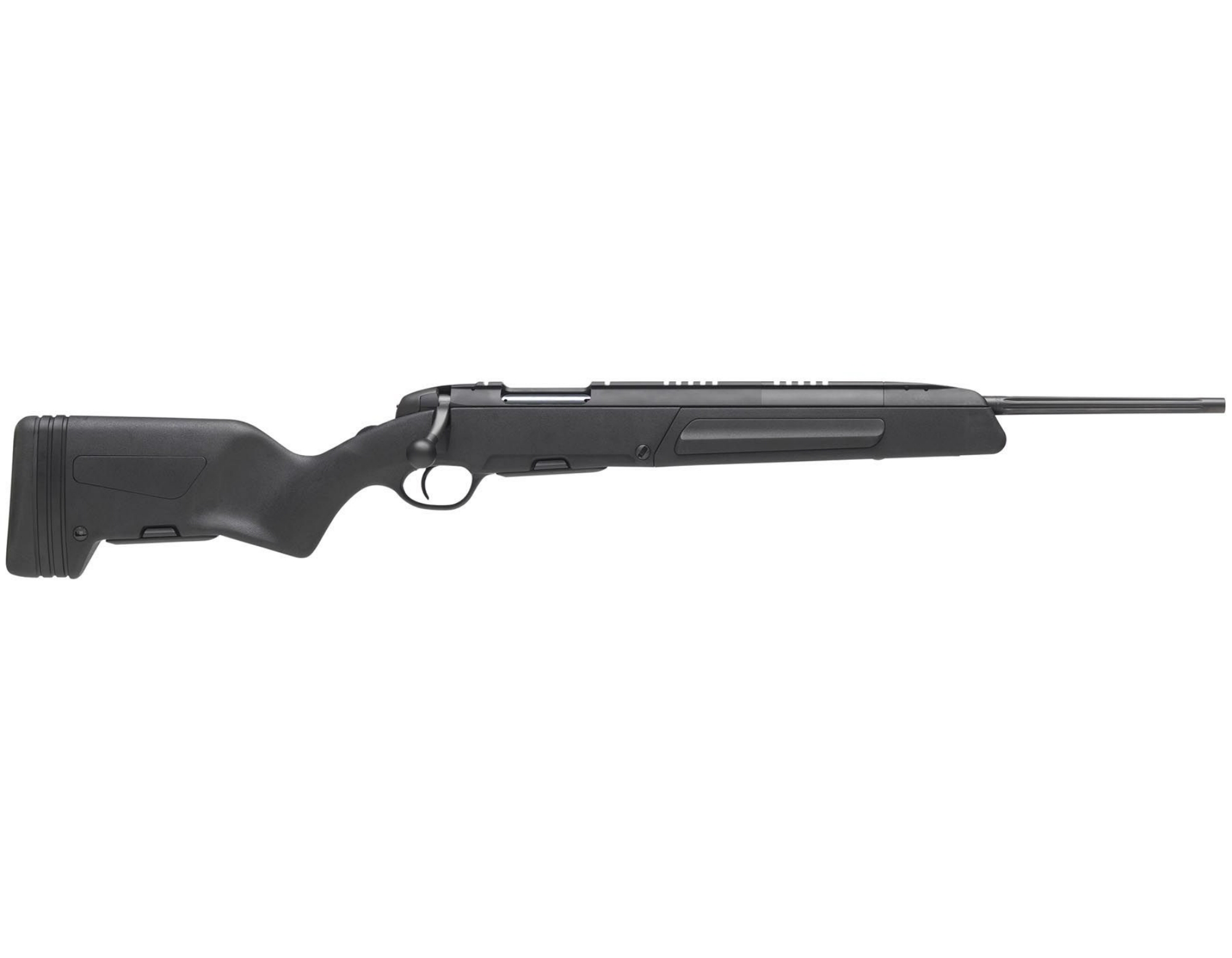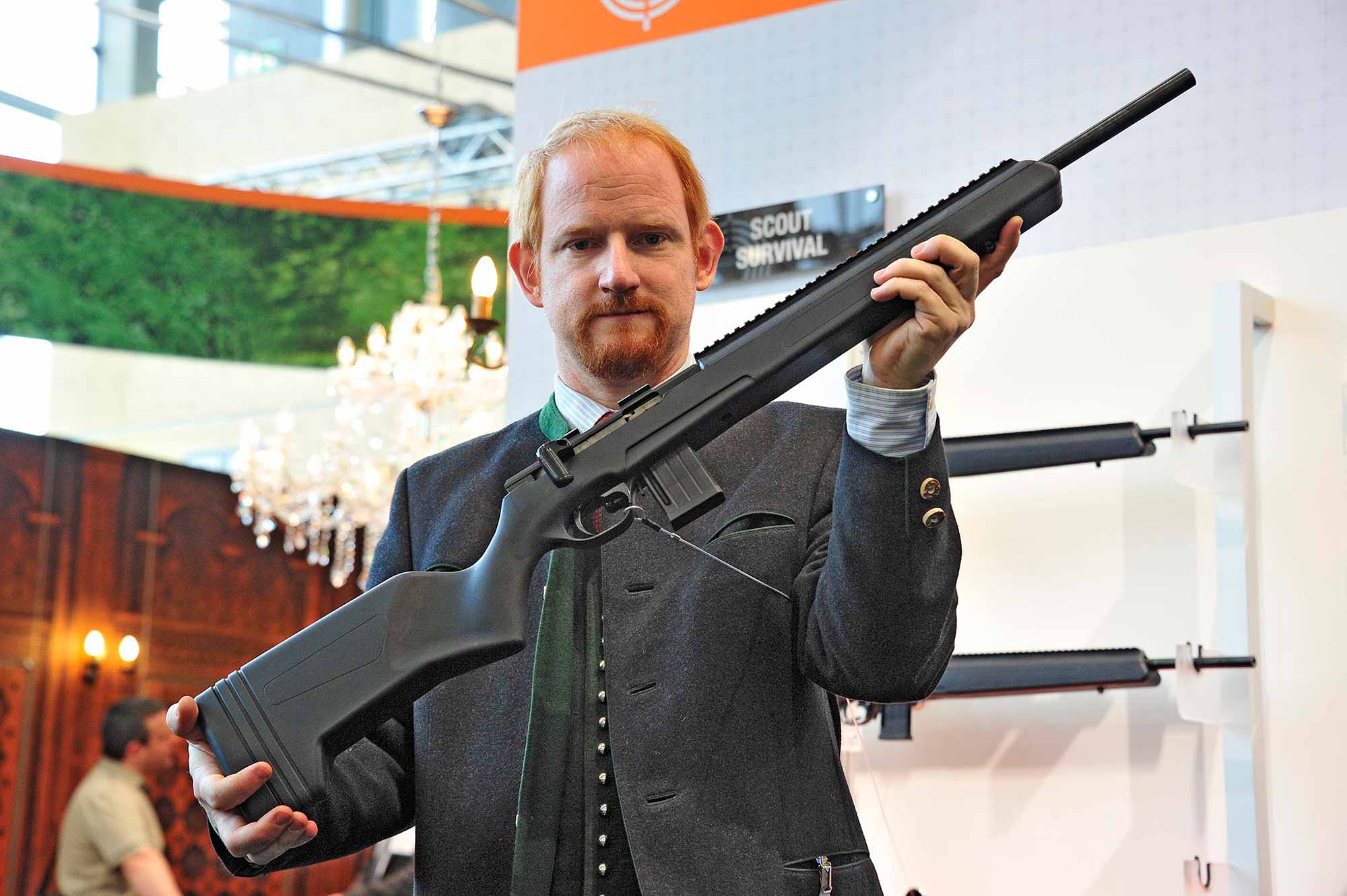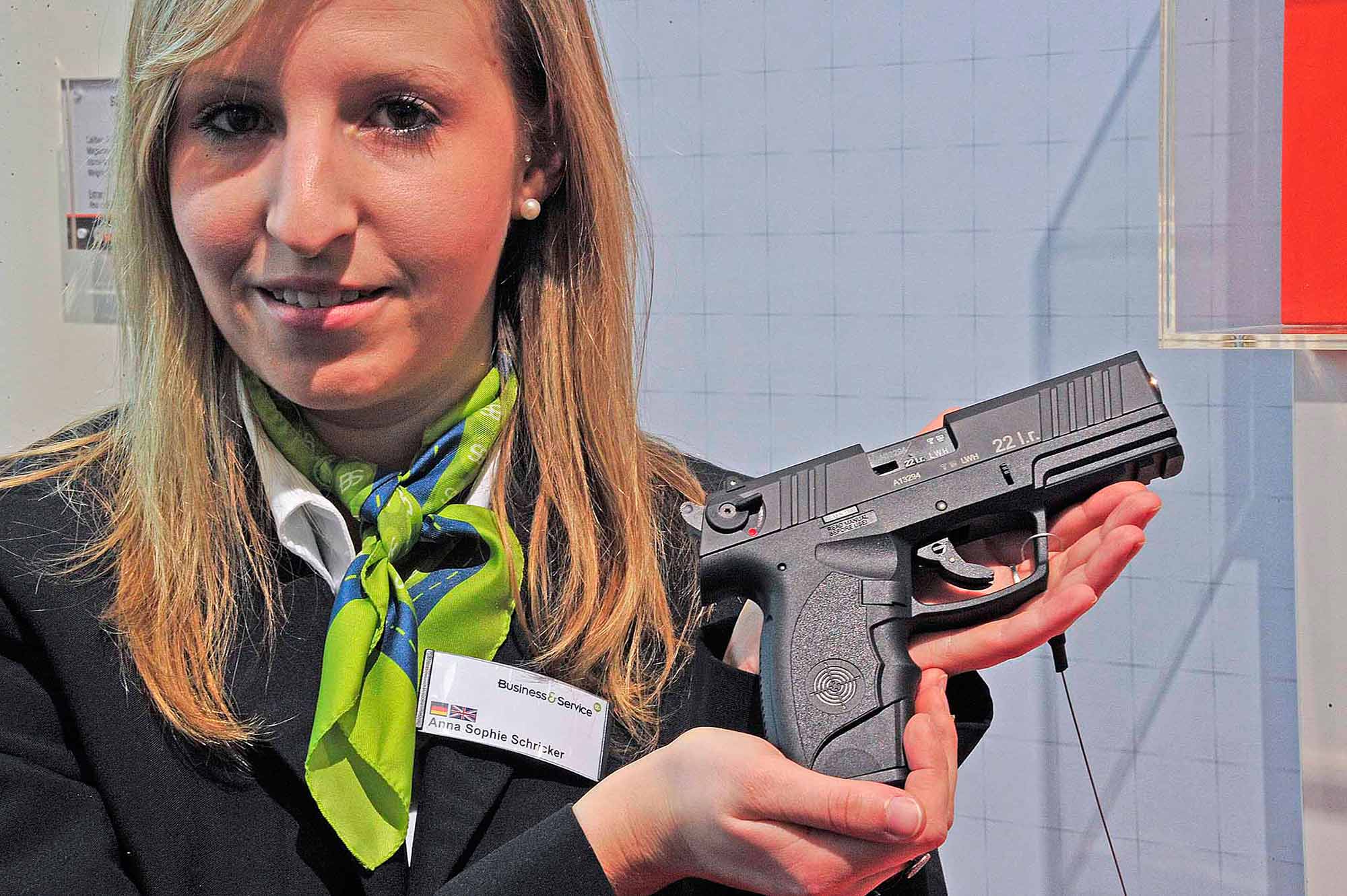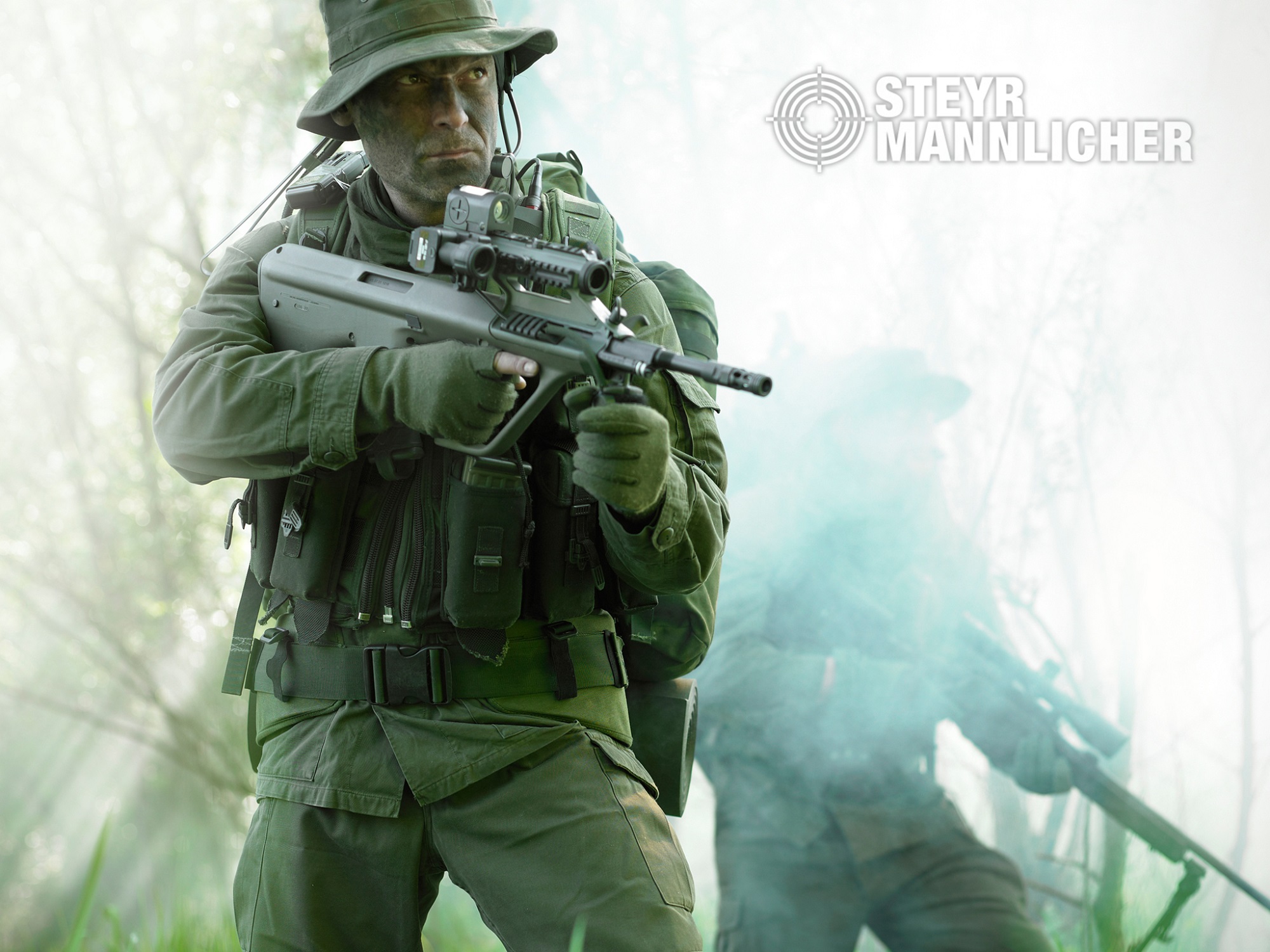The Steyr AUG – Armee Universal Gewehr (Unversal Army Rifle) – was developed in the second half of the 20th century as a substitute for the Stg.58 (Sturmgewehr 58 – Assault Rifle model of 58), licensed local copy of the renowned FN FAL, chambered for the 7.62 NATO cartridge, a very fine but by then obsolete weapon.
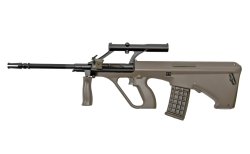
The project was headed by three engineers of the Steyr-Daimler-Puch group (today Steyr-Mannlicher): Horst Wesp, Karl Wagner and Karl Möser.
The gun was developed in close cooperation with the Austrian army: the result was one of the most innovative weapons of those times. Even if none of its characteristics were entirely new (many of its peculiarities had already been seen singularly on several weapons), the Austrian rifle was the first to gather them all in a single weapon of unquestionable effectiveness and great commercial succes.
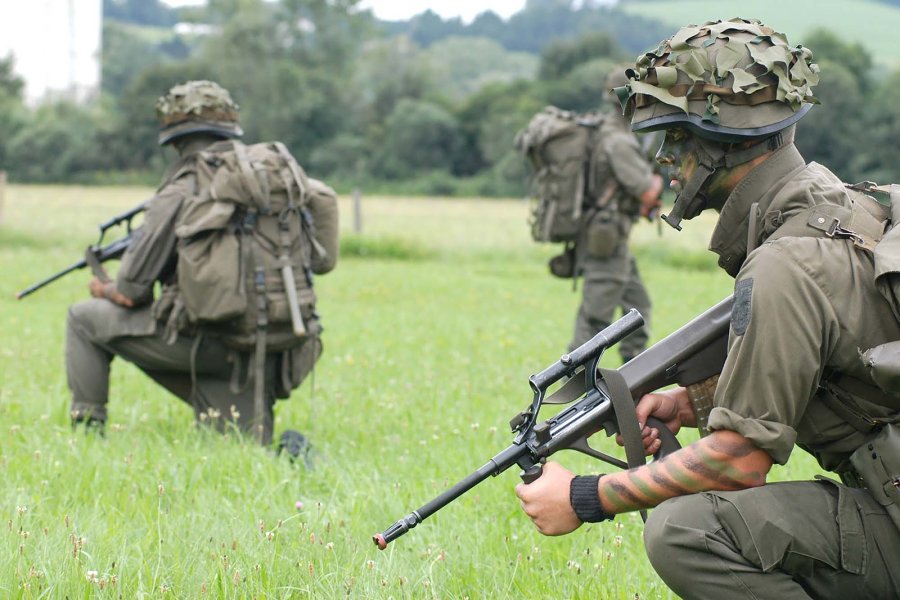
Even if some of these characteristics may now seem obvious, even trivial, we should not forget that the AUG was officially adopted by the Austrian army in 1977 as the Stg.77.
Its most defining property was the bullpup solution: that is, the mechanism and bolt were housed in the stock, behind the grip. This trick allowed for a very compact weapon: with a 20” barrel the AUG was 1.4” shorter than an M4 (with a short 14” barrel) with the stock extended into firing position.
The rifle was built with considerable use of polymers (polyamide 66 with fiberglass) which made the weapon very sturdy, resistant to harsh environmental conditions and very light.
The grip was perhaps the most characteristic component of the design, giving the rifle a futuristic look which was however the result of specific practical needs: instead of a trigger guard, it sports a full length handguard that protects the trigger allowing at the same time the use of winter mitts (a solution since then adopted by several bullpup rifles).
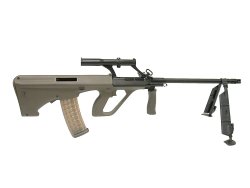
The barrel could be replaced on the field in a matter of seconds with another of different length or section without the need for tools.
This capability makes the AUG one of the first truly modular weapons: i.e. a gun capable of changing its role, from assault rifle to carbine to light machinegun, just by switching barrel and a few other components (the LMG version fires from an open bolt and therefore needs a different bolt and trigger group) whereas other weapons, even more modern and branded as “modular”, need to replace half the rifle to change their role, maintaining just the stock and trigger group of the original gun.
There are three barrel lengths available: 20” (standard rifle version), 16” (carbine version used by airborne toops, vehicle crews, rear echelon personnel, special corps and anybody who needs a light, compact weapon) and 24” heavy barrel for the heavy automatic rifle, LMG and sniper versions.
The barrel locks in place through eight lugs that engage an equal number of detents in a steel bushing fitted to the light alloy upper receiver and features a hard chromed bore and chamber
The first version incorporated an 1.5x optical sight in the integral carry handle, using a ring reticle that granted fast target acquisition and doubled as a range finder, its internal diameter being equal to the apparent size of a 180 cm (6 ft) men at 300 meters.
The controls were very simple: the charging handle on the front left side, the safety button just over the trigger, so that it could be easily disengaged with the trigger finger while assuming a firing stance, and the magazine latch, on the rifle centerline, just behind the magazine well. There was no bolt release lever, as the bolt could be released by pulling slightly on the charging handle.
Finally, there was no fire control switch.
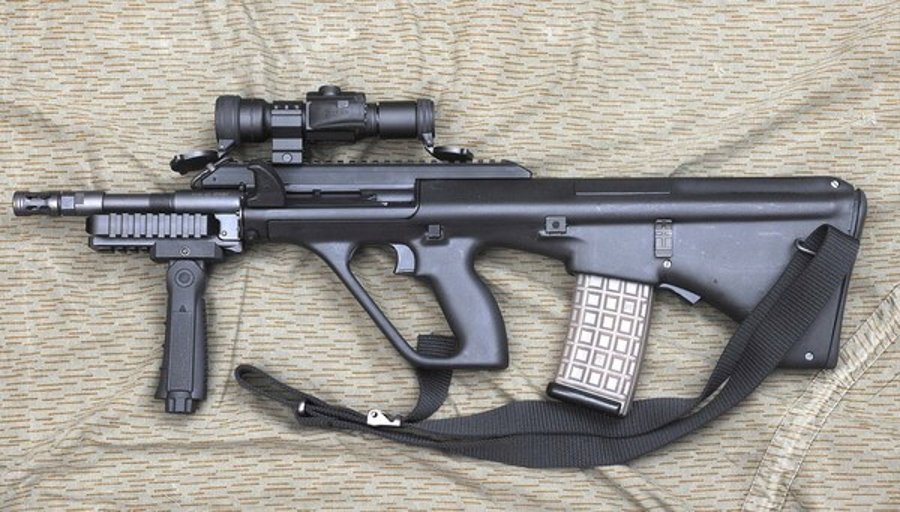
The operator choose between single shot and full auto fire by squeezing the trigger, with a system similar to that adopted for the Wimmersperg Spz-kr, an experimental weapon of the Third Reich which never went beyond prototype: a slight pressure on the trigger, about halfway, fired a single shot, while fully squeezing the trigger produced full auto fire.
Another characteristic, unusual for those times but widespread on a variety of weapons today, was the folding forward grip, which could be used as handguard or, lowering it, as forward grip, for a better control during full auto fire and quick target transitions.
The gun was fed through transparent plastic magazines, which allowed the user to know at a glance how many cartridges were left, and were available both in 30 or 42 shots versions (the latter intended for the LMG version).
These were very tough and reliable magazines, but they weren’t STANAG 4179, that is, they were not interchangeable with those of the AR-15 family.
As futuristic and advanced as the AUG was, during the following years it underwent several modernizations that have kept its cutting edge characteristics always a step forward of its competitors, meeting operative requirements as they become evident with use.
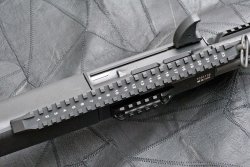
The integrated optical sight, at those times very effective, is today completely obsolete.
The A3 version has abandoned it in favour of a MIL 1913 Picatinny rail that allows for the mounting of a host of different devices.
The forward carrying handle has been substituted with a triple rail to which various accessories can be affixed, from different forward grips (one is issued with the rifle) to tactical lights and lasers.

Moreover there’s a small section of Picatinny rail, angled 45 degrees, on the right side of the receiver. It’s used to mount a light or laser but it can’t be used, as one could believe, for a compact reflex sight to be used in CQB, as the ejection port would be brought just in front of the shooter’s face.
The charging handle can be folded sideways and locked in the open position by rotating it against the receiver about 30 degrees.
The classical tulip shaped muzzle brake which aesthetically characterized the previous versions of the AUG has been substituted by an 8 port muzzle brake-compensator. The compensator can be disassembled (where legal) but the metric barrel threading is not compatible with AR-15 muzzle accessories.
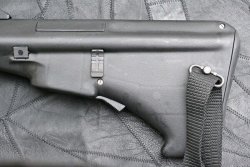
Finally, a bolt release lever has made its appearance, just besides the magazine well, and can be operated with the weak hand after inserting a fresh magazine.
There’s also a verison compatible with STANAG magazines. It’s not just an adapter: it’s a different stock version with a STANAG compliant magazine well and magazine catch.
The rest of the rifle keeps to the original project and can be divided functionally into six components: the barrel with gas group and forward grip; the aluminum alloy upper receiver finished in heat-resistant paint and strenghtened with steel bushings for the barrel socket, bolt lugs and bolt rails; the bolt group with its rails; the trigger group and, finally, the magazine.
The civilian version mounts the 16” inch carbine barrel, resulting far more compact than an M4 with collapsed buttstock.
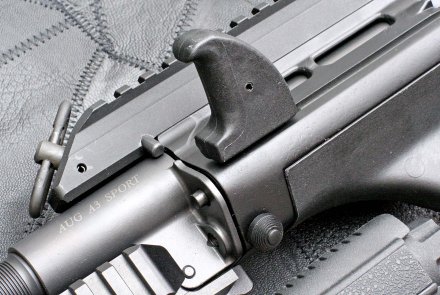
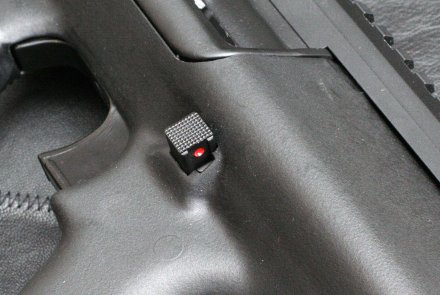
Bolt, bolt carrier and trigger group are specifically designed for the civilian version and allow for semi-automatic fire only. The trigger group, in the civilian as well as military version, is entirely made of polymers, excluding the springs and pins.
The weapon is gas operated with a hard chromed short stroke piston integrated in the barrel group.
Gases are spilled from a small hole in the barrel, which matches with one of two corresponding holes in the gas group valve, which can be rotated to vary the amount of gas acting on the piston. The valve has three positions: a small dot marks the “normal” position, a large dot marks the “dirt/cold” position which allows more gas into the gas group, while the third position, marked with a “G”, closes the gas port, disabling the gas piston for grenade launching. The civilian version has only the first two positions.
Upon reaching the gas group, hot gases push back on the small piston which acts with its rod directly on one of the two guides of the bolt carrier group, transfering its impulse to the bolt carrier group itself.
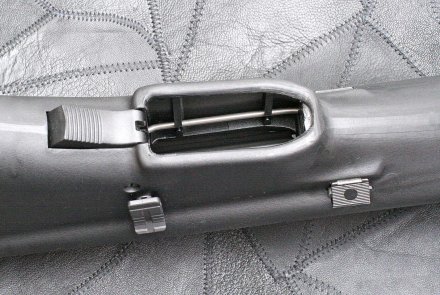
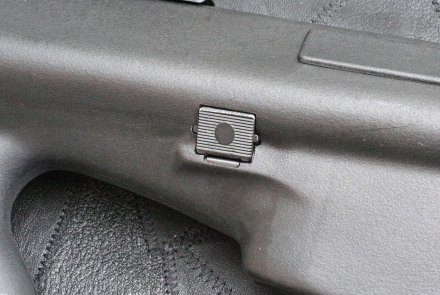
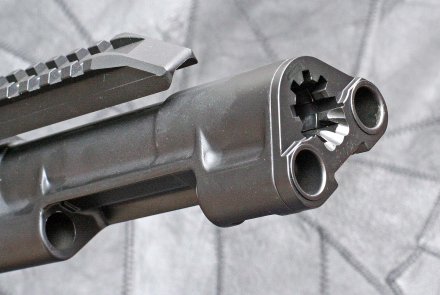
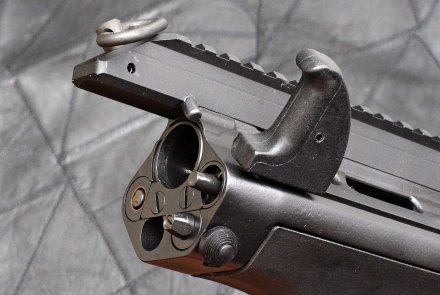
The right guide gets the push from the piston, while the left one is operated by the charging handle, which doesn’t reciprocates with the bolt group, but can be temporarily connected to the guide to work as a forward assist for silent chambering of a round.
The left guide can be also used as a tool to clean the gas group from hard fouling.
The guides contain the recoil springs, that get compressed by two fixed rods in the polymer stock.
When the bolt carrier starts moving backwards, it unlocks the bolt through the classic cammed slot and pin, much like in the AR-15 system.
The spent case is extracted by the claw extractor and expelled through the ejection port by a spring loaded ejector plunger.
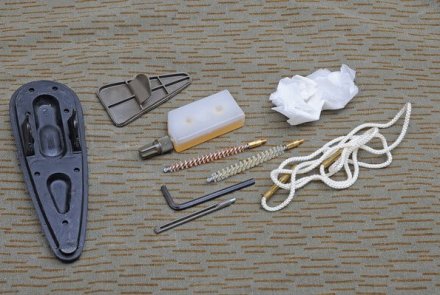
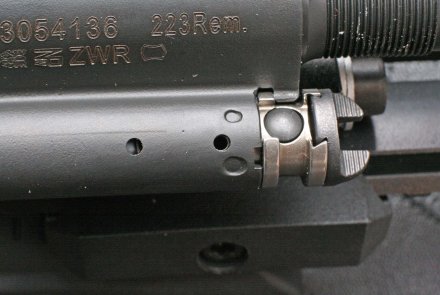
Given the peculiar geometry of the gun, in case of a left handed shooter the ejection port would lay right next to the shooter’s face, which ain’t fun.
For this reason, the gun has two ejection ports and a protection lid that covers the unused one. To make an AUG left-handed you just have to remove the lid from the left port and apply it to the right one and swap the bolt with a left handed one which is identical to its twin but for the mirror switched extractor and ejector.
in all othe aspects the weapon is, if not “completely ambidextrous” like claimed by the maker, quite easy to use for southpaws, as the magazine catch is on the centerline of the gun and the charging handle can be operated easily even without removing the firing hand from the grip, much like a right handed shoopter would operate an AK-47 bolt handle.
Once the spent case has been ejected, the bolt strips a fresh round from the magazine and chambers it. The cycle will be repeated at each trigger pull (on the semiauto version).
Once the last round has been fired, the bolt will remain in the open position signalling end of ammo. All there’s to do to resume firing is to grip the empty magazine with the weak hand, push smartly on the magazine release lever with your thumb and pull it out.
Actually, pushing the magazine release lever causes the magazine to be ejected from the rifle with quite some conviction, so it wouldn’t be strictly necessary to pull it out, but it’s good practice for two good reasons: first, dirt could jam the magazine in place, and you’d look quite the fool standing there with the rifle in one hand, a fresh magazine in the other and the empty one stuck in the mag well.
Second, but not less relevant, AUG magazines are sturdy and reliable as an anvil but they are not your typical AR-15 magazine: at over 70 bucks each, they are not something you’d want to leave laying around. You can discard it in an emergency reload, but it’s far more convenient to keep it if possible.
Once the fresh magazine is in place, all you have to do to resume firing is pushing on the bolt release button. As an alternative, operators accustomed to pulling on the charging handle can still do it.
An important note on the charging handle: you have to grip it from below, with the palm of your hand facing upwards, and not with the hand palm down.
Were you to do so, you’d easily skin your knuckles against the rail edge or accessory mount.
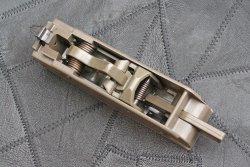
If you keep your hand palm up this doesn’t happen.
For the same reason it’s best to mount devices with any screws, levers or nuts facing right. It’s not such a big issue, as most optical sights have their fasteners facing right anyway.
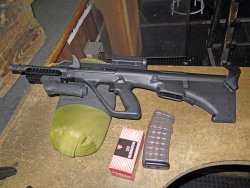
Even if it weighs just 8.1 pounds, the AUG feels much heavier than it actually is due to its compactness, but you shouldn’t be fooled: the gun is extremely well balanced, so much that it is possible to aim it even when gripping it with only one hand, as if it were a giant pistol, as its whole weight balances exactly on the grip.
This compactness allows for lightning fast target transitions, where traditional carbines would have most of their mass far out from the grip.
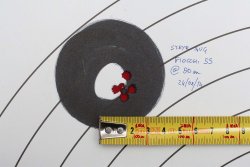
The trigger is quite heavy, but clean and crisp, which is surprising considering that, given the structure of this rifle, it is connected to the trigger group by two long push rods and that the trigger group istelf is made of plastic, which initially left little to hope for as it came to trigger smoothness.
Instead, the trigger is crisp and clean, and trigger reset is short enough, and sharp.
Test firing has been carried out with 55 grain Fiocchi ammo, while aiming has been done through a Hensoldt 3,5x optical sight intended for the G-36 rifle and a Vortex Strikefire with 2x magnifier, just to get the feel of the gun with two different sights and shooting positions (the Hensoldt lies quite low on the rail).
Shooting for accuracy, felt recoil is insignificant, but with the muzzle brake so close to the shooter, the gun report is quite nasty. Good hearing protection is mandatory.
The targets we shot bear witness to the rifle’s accuracy, which is impressive considering that the ammo was intended more for action shooting than for sheer accuracy. With the barrel twist, use of boat-tailed 69 grainers is possible and, reloading with some care, it’s surely possible to squeeze some more MOA fractions out of this rifle.
Forty years after it’s adoption by the Austrian army, the AUG still looks as futuristic as it was at its inception and matches the cool looks with outstanding accuracy, handliness and reliability, which make of this gun a great rifle both for target shooting and small game hunting, as well as a great choice for those who, like yours truly, love to ride to the shooting range on their motorcycle.



